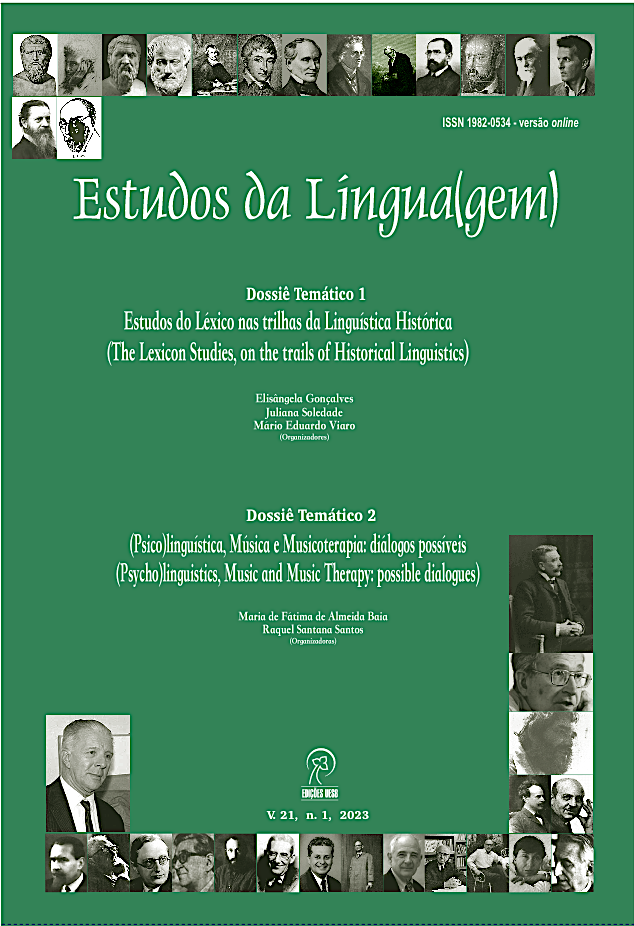El canto infantil y las huellas de su desarrollo: complementariedad entre estudios y teorías
DOI:
https://doi.org/10.22481/el.v21i1.13374Palabras clave:
Canto infantil; Cognición; Complementariedad.Resumen
Para abordar algunos aspectos del canto infantil y su relación con aspectos cognitivos, en este artículo seguimos los siguientes pasos: (1) la habilidad musical se presenta bajo tres miradas diferentes y no excluyentes; (2) se revisan estudios más recientes sobre el desarrollo musical con un enfoque en el canto y (3) finalmente, se aborda el canto espontáneo de los niños. El canto infantil debe ser un objeto de estudio promisorio para comprender la relación entre la percepción del ambiente musical y la producción de canto del individuo en la infancia; y cómo estas percepciones y producciones reflejan el entorno musical y pueden ser lagunas para vislumbrar aspectos de la cognición musical.
Descargas
Citas
BIGAND, E., DELBÉ, C., POULIN-CHARRONNAT, B., LEMAN, M., TILLMANN, B. Empirical evidence for musical syntax processing? Computer simulations reveal the contribution of auditory short term memory. Frontiers in Systems Neurosciences, v. p. 94, jun. 2014. https://doi.org/10.3389/fnsys.2014.00094
BIGAND, E; POULIN-CHARRONNAT, B. Are we “experienced listeners”? A review of the musical capacities that do not depend on formal musical training. Cognition, v. 100, p. 100–130, 2006. doi: 10.1016/j.cognition.2005.11.007
CORBEIL, M., TREHUD, S. E.; PERETZ I. Speech vs singing: Infants choose happier sounds. Frontiers in Psychology, v. 4, p. 372, 2013.
COSTA GIOMI, E.; BENETTI, L. Through a baby’s ears: Musical interaction in a family community. International Journal of Community Music, v. 10, issue 3, p. 55-69. 2017. doi: 10.1386/ijcm.10.3.289_1
COSTA GIOMI, E.; BENETTI, L. Home musical environment and singing development in infancy. In: RUSSO, A.; ILARI, ILARI, B.; ANNABEL, J. COHEN. (eds.). The Routledge Companion to Interdisciplinary Studies in Singing Volume I: Development. 1ed. New York: Routledge Taylor & Francis Group, 2020. p. 189-199.
FALK, S.; TSANG, C. D. The role and functions of infant-directed singing in early development. In: RUSSO, A.; ILARI, ILARI, B.; ANNABEL, J. COHEN. (eds.). The Routledge Companion to Interdisciplinary Studies in Singing Volume I: Development. 1ed. New York: Routledge Taylor & Francis Group, 2020. p. 179-188.
FEDORENKO, E.; PATEL, A. D.; CASASANTO, D.; WINAWER, J.; GIBSON. E. Structural integration in language and music: Evidence for a shared system. Memory & Cognition, v. 37, p. 1-9, 2009.
FONSECA, M. B. P. A produção musical da criança na primeira infância. Monografia de Especialização em Educação Musical. Escola de Música da Universidade de Minas Gerais, 1986.
GUDMUNDSDOTTIR, H.; TREHUB, S. Adults’ recognize toddler' s song renditions. Psychology of Music, v. 46, p. 281-291, 2018.
KESSEN, W.; LEVINE, J.; WENDRICH, K. A. The imitation of pitch in infants. Infant Behavior and Development, v. 2, p. 93-99, 1979.
Patel A. D. Music, Language, and the Brain. Oxford: Oxford University Press, 2008.
LARGE, E. W. Neurodynamics of Music. In: JONES, M. R. s et al. (eds.) Music Perception, Springer Handbook of Auditory Research 36, 2010a. p. 201-226. doi 10.1007/978-1-4419-6114-3_7
LARGE, E. W. A dynamical systems approach to musical tonality. In: HUYS, R.; JIRSA, V. (Eds.), Nonlinear dynamics in human behavior. New York: Springer, 2010b. p. 193-211. doi: 10.1007/978-3-642-16262-6_9
LARGE, E.; KIM, J.; FLAIG, N. N.; BHARUCHA, J.; KRUMHANSL, C. L. A neurodynamic account of music tonality. Music Perception, Vol. 33, no. 3, p. 319-331, 2016. doi: 10.1525/mp. 2016.33.3.319
LERDAHL, F.; JACKENDOFF, R. A generative theory of tonal music. Cambridge: MIT Press, 1983.
MEHR, S. A.; SINGH, M.; KNOX, D.; KETTER, D. M.; PICKENS-JONES, D.; ATWOOD, S.; LUCAS, C.; JACOBY, N.; EGNER, A. A.; HOPKINS, E. J.; HOWARD, R. M.; HARTSHORNE, J. K.; JENNINGS, M. V.; SIMSON, J.; BAINBRIDGE, C. M.; PINKER, S.; O'DONNELL, T. J.; KRASNOW, M. N.; GLOWACKI, L. Universality and diversity in human song. Science, Vol 366, Issue 6468, 2019. Downloaded from http://science.sciencemag.org/ on November 28, 2019.
PAIVA, A.; MACHADO, A.; PARIZZI, B. O canto espontâneo como indicador do desenvolvimento musical de uma criança de quatro anos. Anais do 3º Nas Nuvens... Congresso de Música, 01 a 08 de dezembro de 2017, UFMG, UEMG e King’s Brazil Institute, p. 82-94, 2017. Acessado: 3º Nas Nuvens… Congresso de Música: Anais (2017) – Nas nuvens… Congresso de Música (ufmg.br)
PARIZZI, M. B. A música espontânea da criança como manifestação de seu estágio cognitivo. In: DOTTORI, M.; ILARI, B., SOUZA, R. Anais do 1º. Simpósio Internacional de Cognição e Artes Musicais. Curitiba: Deartes –UFPR, 2005. p. 379-385.
PARIZZI, M. B. O desenvolvimento da percepção do tempo em crianças de dois a seis anos: um estudo a partir do canto espontâneo. Tese (Doutorado em Ciências da Saúde). Faculdade de Medicina, Universidade Federal de Minas Gerais. Belo Horizonte, 2009.
PATEL, A. D. Language, music, and the brain: a resource-sharing framework. In: REBUSCHAT, P.; ROHRMEIER, M.; HAWKINS, J.; CROSS, I. (Eds.), Language and Music as Cognitive Systems. Oxford: Oxford University Press, 2012. p. 204-223.
RAPOSO DE MEDEIROS, B.; CABRAL, J. P.; MEIRELES, A.; BACETI, A. A comparative study of fundamental frequency stability between speech and singing. Speech Communication, v. 128, p. 15-23, 2021. https://doi.org/10.1016/j.specom.2021.02.003
RUSSO, F. A.; ILARI, B.; COHEN, A. J. Singing, development, interdisciplinarity and the biopsychosocial framework. In: RUSSO, A.; ILARI, ILARI, B.; ANNABEL, J. COHEN. (eds.) The Routledge Companion to Interdisciplinary Studies in Singing Volume I: Development. 1ed. New York: Routledge Taylor & Francis Group, 2020. p. 1-14.
STADLER ELMER, S. Human singing: Towards a developmental theory. Psymusichology: Music, Mind and Brain, v. 21, issue 1e 2, p. 13-30, 2012. Doi 10.1037/h0094001
STADLER ELMER, S. (2020). From canonical babbling to early singing and its relation to the beginnings of speech. In: RUSSO, A.; ILARI, ILARI, B.; ANNABEL, J. COHEN (eds.) The Routledge Companion to Interdisciplinary Studies in Singing Volume I: Development. 1ed. New York: Routledge Taylor & Francis Group, 2020. p. 25-38.
Sloboda, J. A. A mente musical: psicologia cognitiva da música. Trad. De Beatriz Ilari e Rodolfo Ilari. Londrina: EDUEL, 2008.
VAN DER SCHYFF, D.; SCHIAVO, A. WALTON, A., VELARDO, V. CHEMERO, A. Musical creativity and the embodied mind: Exploring the possibilities of 4E cognition and dynamical systems theory. Music & Science, v. 1, p. 1-18, 2018. doi.org/10.1177/2059204318792319
TREHUB, S.; RUSSO, F. A. (2020). Infant-directed singing from a dynamic multimodal perspective. In: : RUSSO, A.; ILARI, ILARI, B.; ANNABEL, J. COHEN (eds.) The Routledge Companion to Interdisciplinary Studies in Singing Volume I: Development. 1ed. New York: Routledge Taylor & Francis Group, 2020. p. 249-261.
WARLAUMONT, A. S.; RICHARDS, J. A.; GILKERSON, J.; OLLER, D. K. A social feedback loop for speech development and its reduction in autism. Psychological Science, v. 25, issue 7, p. 1314-1324, 2014. doi.org/10.1177/0956797614531023
Descargas
Publicado
Cómo citar
Número
Sección
Licencia

Esta obra está bajo una licencia internacional Creative Commons Atribución 4.0.

Estudos da Língua(gem) está bajo una Licencia Creative Commons Atribución 4.0 Internacional.
Los autores que publican en el periódico Estudios de la Lengua (g) concuerdan con los siguientes términos:
La revista Estudios del Lenguaje mantiene los derechos de autor de las contribuciones publicadas. Estos derechos incluyen la publicación de la contribución y pondrá a disposición su contenido gratuitamente a través del portal







